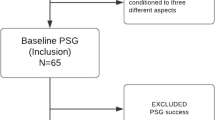Abstract
This case report is the first description of the treatment response to an oral appliance (OA) in a patient with upper airway resistance syndrome (UARS). OAs are devices inserted into the mouth in order to modify the position of the mandible and tongue, thus relieving pharyngeal obstruction during sleep in obstructive sleep apnea (OSA) patients. Findings from this case report suggest that an OA may be a useful treatment option for UARS patients.
Similar content being viewed by others
Abbreviations
- OA:
-
oral appliance
- UARS:
-
upper airway resstance syndrome
- OSA:
-
obstructive sleep apnea
- Pes:
-
esophageal pressure
- CPAP:
-
continuous positive airway pressure
- UPPP:
-
uvulopalatopharyngoplasty
- NPSG:
-
nocturnal polysomnography
- EEG:
-
electroencephalography
References
Guilleminault C, Stoohs R, Clerk A, Cetel M, Maistros P. A cause of excessive daytime sleepiness: the upper airway resistance syndrome. Chest 1993; 104:781–87.
Guilleminault C, Stoohs R, Kim Y, et al Upper airway sleep-disordered breathing in women. Ann Intern Med 1995; 122:493–501.
Strollo PJ, Sanders MH. Significance and treatment of nonapneic snoring. Sleep 1993; 16:403–8.
Chervin RD, Guilleminault C. Obstructive sleep apnea and related disorders. Neurol Clin 1996; 14:583–609.
Newman JP, Clerk AA, Moore M, Utley DS, Terris DJ. Recognition and surgical management of upper airway resistance syndrome. Laryngoscope 1996; 106:1089–93.
Johns, MW. A new method for measuring daytime sleepiness: the Epworth Sleepiness Scale. Sleep 1991; 14:540–5.
Rechtstaffen, A, Kales A. A manual of standardized terminology: techniques and scoring system for sleep stages of human subjects. National Institutes of Health publication No. 204, 1994. Washington DC: United States Government Office.
Mitler, MM, Poceta SJ, Bigby BJ. Sleep scoring technique. In: Chokoverty P, ed. Sleep Disorders Medicine. Boston, MA: Butterworth-Heinemann, 1994; 155–72.
Mathur R, Douglas NJ. Frequency of EKG arousals from nocturnal sleep in normal subjects. Sleep 1995; 18:330–33.
Gold AA, Schwartz AR. The pharyngeal critical pressure: the whys and hows of using nasal continuous positive airway pressure diagnostically. Chest 1996; 110:107788.
Condos R, Norman RG, Krishnasamy I, et alt Flow Limitation as a noninvasive assessment of restdual upper-airway resistance during continuous positive airway pressure treatment of obstructive sleep apnea. Am J Resp Crit Care Med. 1994; 150:47580.
Montserrat JM, Ballester E, Olivi H, et alt Timecourse of stepwise CPAP titration. Behavior of respiratory and neurological variables. Am J Resp Crit Care Med 1995;. 152:1854–59.
American Sleep Disorders Association Standards of Practice Committee. Practice parameters for the treatment of snoring and obstructive sleep apnea with oral appliances. Sleep 1995; 18:501–10.
Ferguson KA, Ono T, Lowe AA, Keenan SP, Fleetham JA. A randomized crossover study of an oral appliance versus nasal continuous positive airway pressure for the treatment of mild-moderate obstructive sleep apnea. Chest 1996; 109:1269–75.
Clark GT, Blumenfeld I, Yoffe N, Peled E, Lavie P. A crossover study comparing the cfficacy of continuous positive airway pressure with anterior mandibular positioning device on patients with obstructive sleep apnea. Chest 1996; 109:1477–83.
Menn SJ, Loube DI, Morgan TD, et alt The mandibular repositioning device: role in the treatment of obstructive sleep apnea. Sleep 1996; 19:794–800.
Levy PJ, Pepin J, Mayer P, Wuyam B, Veale, D. Management of simple snoring, upper airway resistance syndrome, and obstructive sleep apnea. Sleep 1996; 19:S101–10.
Guilleminault C, Kim Y, Stoohs R. Upper airway resistance syndrome. Oral Maxillo Surg Clin 1995; 7:243–56.
Author information
Authors and Affiliations
Corresponding author
Additional information
The opinions or assertions contained herein are the private views of the authors and do not necessarily represent the opinion of the Department of the Army or of the Department of Defense.
Rights and permissions
About this article
Cite this article
Loube, D.I., Andrada, T., Shanmagum, N. et al. Successful treatment of upper airway resistance syndrome with an oral appliance. Sleep Breath 2, 98–101 (1997). https://doi.org/10.1007/BF03039004
Received:
Accepted:
Issue Date:
DOI: https://doi.org/10.1007/BF03039004




